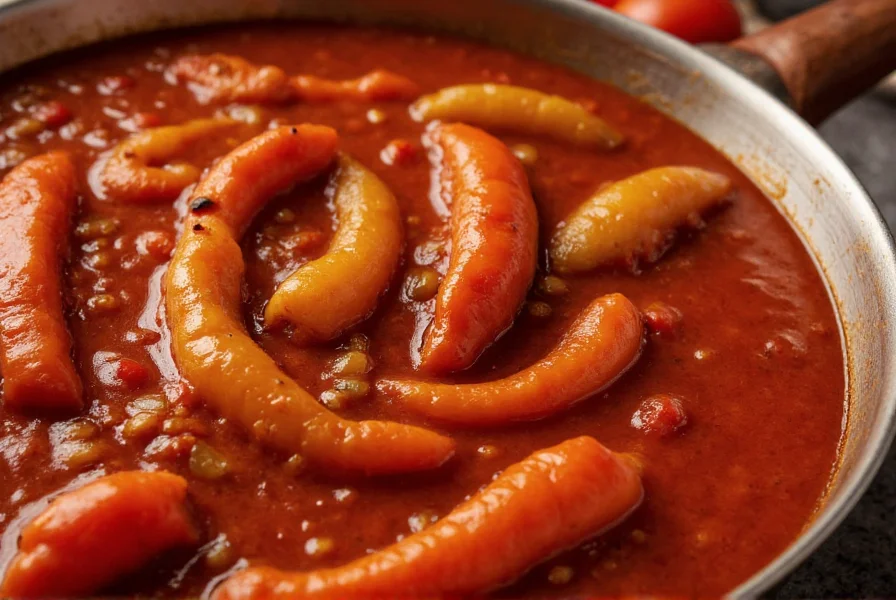When exploring how hot is 5 alarm chili compared to other spice levels, it's essential to understand this isn't an official industry standard but rather a marketing term used by restaurants and food producers to indicate extreme heat. The "alarm" system provides a more accessible way for consumers to gauge spiciness than the technical Scoville scale.
Understanding the Alarm Heat Rating System
The alarm rating system emerged as a consumer-friendly alternative to the Scoville scale, which measures capsaicin concentration in pepper extracts. While not scientifically precise, this informal scale helps diners anticipate heat levels:
| Alarm Level | Scoville Range | Pepper Equivalents | Consumer Experience |
|---|---|---|---|
| 1-2 Alarm | 5,000-30,000 | Jalapeño to Serrano | Mild to moderate heat, approachable for most |
| 3 Alarm | 50,000-100,000 | Habanero | Significant heat, challenging for average eaters |
| 4 Alarm | 150,000-300,000 | Red Savina Habanero | Very hot, causes physical reactions in many |
| 5 Alarm | 250,000-500,000+ | Ghost Pepper blends | Extreme heat, requires preparation and caution |
Many consumers searching for 5 alarm chili vs 4 alarm differences want to understand the practical implications of that extra "alarm." The jump from 4 to 5 alarm typically represents crossing into territory where the heat becomes the dominant experience rather than a complement to flavor. At 5 alarm levels, the capsaicin concentration often triggers noticeable physical reactions including sweating, facial flushing, and increased heart rate.
What Peppers Create Authentic 5 Alarm Heat
Understanding what peppers are in 5 alarm chili reveals why this heat level commands respect. While recipes vary, authentic 5 alarm preparations typically combine:
- Habanero peppers (100,000-350,000 SHU) - providing fruity undertones beneath intense heat
- Scotch bonnet peppers (100,000-350,000 SHU) - similar to habaneros with slightly different flavor profile
- Ghost peppers (Bhut Jolokia) (800,000-1,041,427 SHU) - often used in smaller quantities to push into 5 alarm territory
- Trinidad Moruga Scorpion (1,200,000+ SHU) - occasionally incorporated for extreme versions
The art of creating balanced 5 alarm chili involves more than just dumping in super-hot peppers. Experienced makers understand that 5 alarm chili recipe ingredients must include elements that complement rather than merely withstand the heat. Tomatoes, onions, garlic, cumin, and oregano form the flavor foundation, while dairy components like cheese or sour cream in the serving preparation help moderate the heat experience.

Experiencing 5 Alarm Chili: What to Expect
Before diving into a bowl of 5 alarm chili, understanding is 5 alarm chili too hot for your tolerance level is crucial. The experience unfolds in distinct phases:
- Initial contact (0-15 seconds): Flavor notes register before significant heat
- Building heat (15-45 seconds): Warming sensation spreads across tongue and mouth
- Peak intensity (1-3 minutes): Full heat impact with potential physical reactions
- Aftermath (5-30 minutes): Lingering heat that gradually subsides
Unlike milder chilies where heat serves as a background note, 5 alarm preparations make heat the central experience. Many restaurants offering 5 alarm challenges require participants to sign waivers acknowledging the potential for discomfort. The intense capsaicin concentration triggers endorphin release, creating the "chili high" that enthusiasts seek, but novices should approach with caution.
Creating Balanced 5 Alarm Chili at Home
For those attempting 5 alarm chili heat level preparations at home, proper technique separates a one-dimensional burn from a complex culinary experience. Key considerations include:
- Pepper preparation: Removing seeds and membranes reduces heat while preserving flavor
- Gradual heat building: Adding hot peppers incrementally to control final intensity
- Flavor balancing: Using acidic components like tomatoes to cut through heat
- Resting time: Allowing chili to sit for 24 hours helps flavors meld and heat distribute evenly
Professional chili makers emphasize that the best 5 alarm preparations maintain discernible flavor notes beneath the heat. When executed properly, you should detect the earthy cumin, sweet tomatoes, and smoky undertones even as the heat registers. This balance distinguishes authentic 5 alarm chili from mere hot pepper infusions.

Commercial 5 Alarm Chili Products
The market offers various 5 alarm chili commercial products, though quality and authenticity vary significantly. When evaluating store-bought options:
- Check ingredient lists for actual hot peppers rather than just "natural flavors"
- Look for products specifying pepper varieties used
- Consider regional specialties from areas with authentic chili traditions
- Beware of exaggerated marketing claims without supporting details
Reputable producers typically provide heat warnings and serving suggestions, recognizing that 5 alarm intensity requires proper handling. Some specialty food companies now include QR codes linking to detailed information about their pepper sources and heat testing procedures, adding transparency to an otherwise subjective rating system.
Frequently Asked Questions
How does 5 alarm chili compare to pure capsaicin?
5 alarm chili typically ranges from 250,000-500,000 Scoville units, while pure capsaicin measures 16,000,000 units. Even the hottest 5 alarm preparations are significantly milder than pure capsaicin, which is used in laboratory settings and pepper sprays rather than food.
Can you build tolerance to 5 alarm chili over time?
Yes, regular consumption of spicy foods can increase your tolerance through desensitization of TRPV1 receptors. However, this adaptation has limits, and sudden jumps to 5 alarm heat levels can still overwhelm even experienced eaters. Gradual progression through lower alarm levels is recommended.
What's the best way to cool your mouth after eating 5 alarm chili?
Dairy products containing casein (milk, yogurt, sour cream) provide the most effective relief as casein binds to capsaicin. Sugar-containing foods like honey or sweetened beverages can also help, while water merely spreads the oil-based capsaicin. Avoid alcohol, which can intensify the burning sensation.
Does cooking time affect the heat level of 5 alarm chili?
Yes, extended cooking time (6+ hours) can slightly reduce perceived heat as capsaicin breaks down, but the effect is minimal. More significantly, longer cooking allows flavors to meld, creating the perception of better balance. The primary heat level remains largely intact regardless of cooking duration.
Are there health benefits to consuming extremely hot chili like 5 alarm?
Capsaicin in hot peppers offers potential benefits including pain relief, improved metabolism, and anti-inflammatory properties. However, at 5 alarm levels, the intense heat may cause gastrointestinal distress that outweighs potential benefits for many people. Moderate consumption of spicier foods (2-3 alarm) typically provides benefits without extreme discomfort.











 浙公网安备
33010002000092号
浙公网安备
33010002000092号 浙B2-20120091-4
浙B2-20120091-4